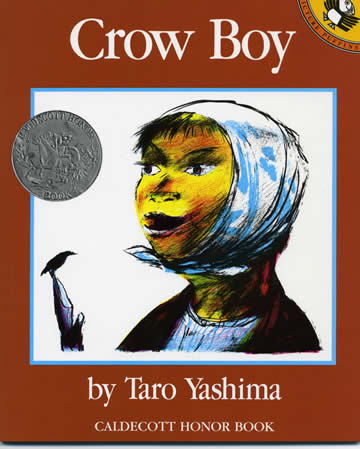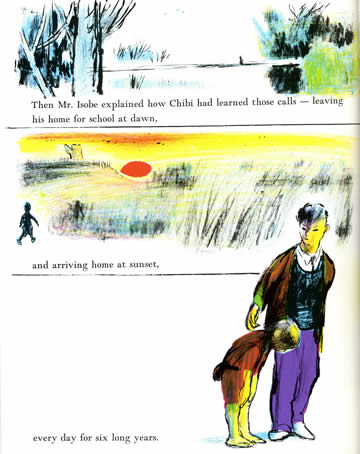Introduction

The purpose of this activity is to focus an analysis on story telling as a process of communication of tone with conceptual and emotional understanding using illustrations and normal everyday wording; as opposed to only with powerful use of words and phrasing. Hopefu
lly, to expand our understanding of the importance of communication that relates to the readers and viewers experiences, beliefs, and understandings so we as educators understand the essential importance of fitting literature and instructional pedagogies to match the needs of diverse learners for them to choose to view and read literature to achieve literacy and a love of learning.
Directions
Read an illustrated picture book and do the following tasks.
The sample critique included is for - Crow Boy by Taro Yashima.
Sample illustrations for Crow Boy.
1. Select one feeling from the story. Determine a name for that feeling.
- Explain why that feeling was selected.
- Explain how the story communicates that feeling.
- Describe where in the story that information is found.
2. Identify other feelings that could have been selected.
- Explain why that feeling was selected.
- Explain how the story communicates that feeling.
- Describe where in the story that information is found.
3. Select a color, shape, or line(s) that might communicate that feeling. [Black, blue, midnight blue; half-circle (setting sun) tear drop; happiness blue sky, grass green.]
- Explain how that color, shape, or line(s) might communicate that feeling.
4. Identify other colors, shapes, or lines that might communicate that feeling.
- Explain how that color, shape, or line(s) might communicate that feeling
5. Describe where in your life or other people's lives this story would make sense to them.
- Describe where in the story you found your idea(s).
6. Draw a sketch for the story and explain how it relates to the story. Be creative, invent new ways of interpretation.
(No excuses or comments about ones ability to draw or sketch allowed. --- Sponge Bob Square Pants --- A sketch or drawing no matter how it's drawn can communicate more than a picture or masterpiece by the greatest artist.)
7. Share what you learned with your group.
8. Explain the merits and concerns with this type of activity to promote a productive literary talk?
Sample illustrations from
Crow Boy
by Taro Yashima



Critique of Crow Boy
Almost everyone that reads or has Crow Boy read to them, has a response to both the text and pictures. They respond to the text and story literally and individually from everyday events and its description with everyday words, which have little or no significant emotional feeling or intellectual prowess. Likewise the drawings are simple sketches with raw edges and simple lines as backgrounds or different surfaces. The story is little more than a matter of fact biographical report of a child’s school career. (sample illustrations)
The use of the words:
- missing, left, alone, end, foot, afraid, and not are used to negate things.
- The words - stupid, slowpoke, trudging in and alone, are not emotionally powerful, but those few, not so ominous words, powerfully described the negative feelings and actions that other characters had or exhibited toward Chibi.
- The only creative phrase in the story is - “forlorn little tag-along”.
However, the author and illustrator are able to move the reader through several rises and falls with their descriptions and plot. The plot starts quickly and begins to build empathy for Chibi with the introduction of the word missing at the end of the first sentence. The reader is saddened further in the pages that follow with several negative descriptions. Then for a few pages the reader is picked up with a description that includes - sense of curiosity and wonder that Chibi possesses. Then back down with teasing and such on the following pages. Next a time shift of five years that forewarns of a change. Bham.
A new teacher… Wonderment combines with learning and acceptance for several pages and culminates in acceptance and celebration of Chibi. --- the end.
Critique Activity comments related to professional development
This is my interpretation. There are many others. This isn't the right answer. I offer it for two reasons. First, It describes a way to think and analyze stories. A productive use of time is go back through a book or other literary piece, re-examine it, and describe how the ideas flow together to make a story as interpreted by readers.
This is the kind of experiences I encourage you to collect and think about using. You may also elect to use them in the activities and tasks for this class. Anything that creates this kind or response is quality literature.
Beyond the critique.
I have used Crow Boy and this activity with students, It is a fairly simple activity that always creates a nice variety of responses drawn and described by students. Where does all the variety and similarity come from? It is of a cultural origin. Students take the author’s and illustrator’s creation and responded to them with their cultural experiences to represent their personal meaning of the text and pictures. This results in an expansion of the simple words used in a matter of fact narrative to a wealth and variety of ideas possible within a class. That is the value and marvel of diversity we want and need to have from a piece of literature to ensure readers, our students, respond so literature in a way that positively meets their aesthetic needs. That kind of response comes from quality literature. It can come with an aid of a worksheet. But not from a worksheet or workbook designed for skill development or maintenance.
In conclusion. Often it can be a word or image for which we recognize its literal intent, but we read on and subsequently overlook or do not recognize the emotional affect it has on us. The combination of these low key tiny messages support an imaginary and literate telling of a story or message and alter or manipulate all the responses we have, conscious or not. In a way this is human nature. We can’t possibly deal with everything, so we consciously or unconsciously have trained or brain to pick and choose. Sometimes the choices are good and sometimes not. Good authors are able to communicate in a way to achieve a response from a variety of readers.
For teachers the different choices people make, result in the differences of people's beliefs about children and how their needs can best be meet. If they believe there are significant differences that result from a variety of cultural backgrounds, then they will plan to meet those differences. If they do not, then they will treat all students similarly and not make significant changes according to each child's cultural background.
Suggestions for professional development
To review or learn of possible culture sources impacts on literacy with literature, I would suggest - Literature and Justice for All. The first few chapters are research based and some find difficult to read. However, the information is very powerful and important. Those with a political bent will find it most interesting. Later chapters are easier and more practical.
Another way to help learners from different cultures develop insight, understanding, and the ability to analyze can be through multiple forms of literature. To better understand possibilities of integrated experiences, I would suggest - Multiple Forms of Literacy.
To find more specific examples of how to encourage deep analysis of literature, I would suggest - Thinking Through Genre: Units of Study in Reading and Writing Workshops Grades 4-12.
To read about a teacher's experience with using books in her classroom and how she encourage students to read beyond what learners usually read, try - The Book Whisperer: Awakening the Inner Reader in Every Child.
To read about how a teacher used a media event to motivate learners to the world of literature, try - Teaching Youth Media: A critical guide to literacy, video production, and social change.
One important element that I sometimes hear people saying some children seem to lack is imagination. To investigate the relationship between literature and imagination, try - Imagination and Literacy : A Teacher's Search for the Heart of Learning.
My hope is to help us become better with our analysis of literature and create ideas and activities in our classroom to help learners to help each other - learn to enjoy and love literature.
Worksheet
Title
Media - picture book
Author
Directions
Read an illustrated picture book and answer the following questions.
Select one feeling you had from the story.
Determine a name for that feeling.
Why did you select the feeling?
How does the story communicates that feeling?
Describe where in the story that information is found.
Identify other feelings that could have been selected.
Explain why that feeling was selected.
Explain how the story communicates that feeling.
Describe where in the story that information is found.
Select a color, shape, or line(s) that might communicate that feeling. [Black, blue, midnight blue; half-circle (setting sun) tear drop; happiness blue sky, grass green.]
Explain how that color, shape, or line(s) might communicate that feeling.
Identify other colors, shapes, or lines that might communicate that feeling.
Explain how that color, shape, or line(s) might communicate that feeling
Describe where in your life or other people's lives this story would make sense to them.
Describe where in the story you found your idea(s).
Draw a sketch for the story and explain how it relates to the story. Be creative, invent new ways of interpretation. (No excuses or comments about ones ability to draw or sketch allowed. --- Sponge Bob Square Pants --- A sketch or drawing no matter how it's drawn can communicate more than a picture or masterpiece by the greatest artist.)
Share what you learned with your group.
Explain the merits and concerns with this type of activity to promote a productive literary talk?